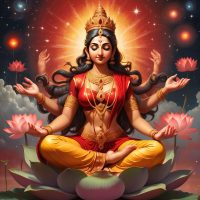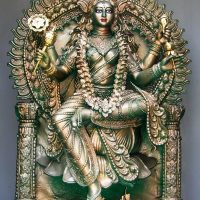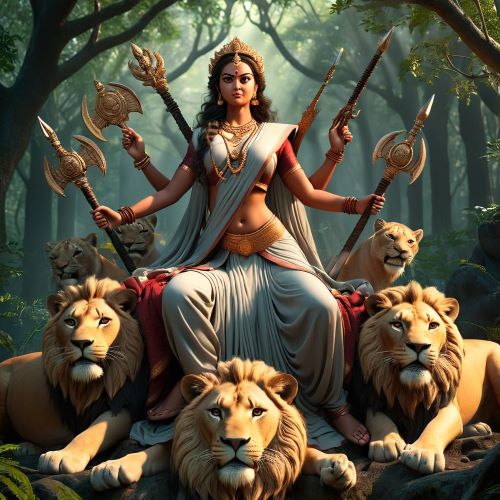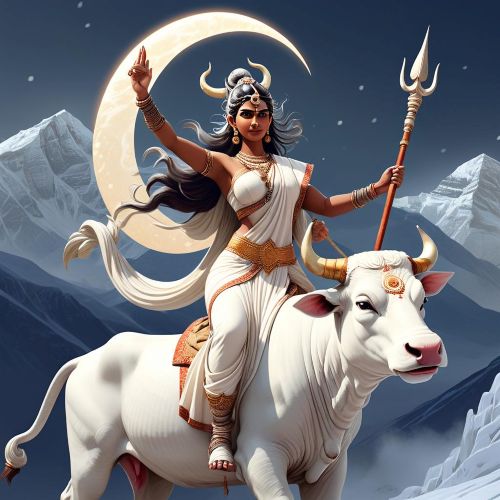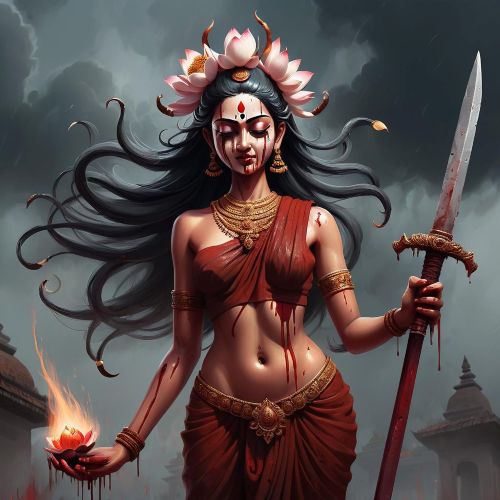Siddhidatri : Goddess of Spiritual Powers
Listen
At a glance
| Description | |
|---|---|
| Origin | Indian Mythology |
| Classification | Gods |
| Family Members | Shiva (Father) |
| Region | India |
| Associated With | Bestowing Powers |
Siddhidatri
Introduction
Siddhidatri, the ninth and final manifestation of Goddess Durga, occupies a unique place in Hindu mythology and spiritual tradition. Her name is formed from two Sanskrit words—Siddhi, meaning spiritual powers or accomplishments, and Datri, meaning giver. True to her name, Siddhidatri is the divine force who bestows mystical powers, wisdom, and enlightenment upon gods, sages, and devotees alike. Worshipped on the ninth day of Navaratri, she represents the pinnacle of spiritual attainment and the culmination of divine feminine energy. More than just a deity of miracles, Siddhidatri is seen as the embodiment of cosmic perfection, guiding worshippers beyond material existence toward liberation and self-realization.
Physical Traits
In Hindu iconography, Siddhidatri is depicted as a serene and radiant goddess seated gracefully on a lotus, the eternal symbol of purity and spiritual awakening. In some traditions, she is also shown riding a lion, highlighting her strength and protective aspect. She is portrayed with four arms, each carrying a symbolic object. The chakra, or discus, represents the eternal flow of time and cosmic law. The shankha, or conch shell, symbolizes the primordial sound from which creation began. The mace embodies authority and power, while the lotus reflects purity, growth, and transcendence. Her golden or fair complexion radiates calmness, and her tranquil expression emphasizes her role as a compassionate granter of wisdom. Artistic depictions often include celestial beings—siddhas, devas, gandharvas, and yakshas—gathering in reverence, which signifies her universal acceptance and dominion across all cosmic planes.
Family
As one of the forms of Durga, Siddhidatri is intimately linked with Shiva. According to ancient texts, Lord Shiva worshipped Siddhidatri and was blessed with all siddhis by her grace. It is also believed that she became one half of Shiva’s form, creating the composite deity Ardhanarishwara—half male and half female—representing the inseparability of masculine and feminine energies in the cosmos. This union is considered a profound symbol of balance, showing that creation is only possible when both energies coexist in harmony. In another strand of mythology, Siddhidatri played a pivotal role in providing divine consorts to the Trimurti: Lakshmi to Vishnu, Saraswati to Brahma, and Parvati herself to Shiva. This act positioned her as a cosmic matriarch who ensured the orderly functioning of creation, preservation, and destruction, thereby stabilizing the universe’s cyclical rhythm.
Other names
The goddess Siddhidatri is revered by multiple names, each reflecting her attributes and significance. She is frequently called Navadurga as the final and culminating form in the nine manifestations of Durga. Many texts also refer to her as Mahashakti, the supreme power that underlies all creation. In connection with her unity with Shiva, she is called Ardhanarishwari, representing the eternal feminine within the androgynous form of Ardhanarishwara. Devotional hymns sometimes invoke her as Kamala-sthita, meaning one who resides upon a lotus, reinforcing her association with purity and enlightenment. Each of these epithets expands on her role, whether as a cosmic force, a bestower of power, or a spiritual guide.
Powers and Abilities
Siddhidatri’s greatest distinction lies in her ability to grant siddhis, supernatural powers that go beyond ordinary human capacities. Hindu scriptures, including the Markandeya Purana, describe eight principal siddhis that she confers: Anima (the ability to become minute), Mahima (the power to expand infinitely), Garima (the ability to grow infinitely heavy), Laghima (the ability to become weightless), Prapti (the capacity to obtain anything), Prakamya (the ability to fulfill any desire), Ishitva (lordship or supremacy), and Vashitva (control over all forces of nature). Beyond these eight, traditions often speak of her granting a total of eighteen siddhis, which Lord Shiva himself is said to have received through her blessings. Her powers are not limited to granting miracles; they encompass the removal of ignorance, the granting of knowledge, and the fulfillment of both material aspirations and spiritual goals. Through Siddhidatri, devotees are said to realize that all divine power rests within her, leading them toward moksha, or ultimate liberation from the cycle of birth and death.
Modern Day Influence
Even today, the influence of Siddhidatri is deeply felt in Hindu culture and spiritual practices. During Navaratri, her worship on the ninth day—Navami—is celebrated with great devotion, where rituals, fasting, and mantra chanting are performed to invoke her blessings. The color pink, associated with compassion and love, is traditionally worn on this day to honor her gentle energy. In Vedic astrology, Siddhidatri is linked with the planet Ketu, which governs past-life karmas and spiritual detachment. Devotees pray to her for relief from Ketu’s malefic influences, believing her grace can remove obstacles to spiritual progress.
Her symbolism also extends into other traditions and philosophies. In Jainism, the concept of siddhas, or liberated souls, echoes her role as a divine force leading beings toward perfection and freedom from worldly bondage. In Vajrayana Buddhism, siddhis appear in tantric practices, reflecting a similar pursuit of mystical accomplishments.
In modern discourse, Siddhidatri is frequently cited as a source of empowerment, especially for those exploring the balance of masculine and feminine energies within. The Ardhanarishwara symbolism tied to her is often referenced in discussions of gender fluidity and cosmic duality, making her mythology relevant in contemporary theology and cultural studies. Her imagery and narratives inspire art, literature, and meditation practices, while yoga communities draw upon the idea of siddhis as stages of advanced spiritual achievement.
In popular culture, her story is retold through digital media, devotional music, and temple art, continuing her legacy as a divine mother who bridges myth, philosophy, and everyday life. For spiritual seekers today, Siddhidatri remains a beacon of hope, guiding them toward harmony, fulfillment, and enlightenment.
Related Images
Source
Dhallapiccola, A. (2002). Dictionary of Hindu Lore and Legend. Thames & Hudson.
Indian Mythology Stories. (2024, September 18). What is the story behind goddess Siddhidatri? https://indianmythology.co.in/what-is-the-story-behind-goddess-siddhidatri/
Lovenspire. (2025, September 11). Navratri Day 9: Maa Siddhidatri, Bestower of Supernatural Powers. https://lovenspire.com/blogs/lovenspire-blog-corner/navratri-day-9-siddhidatri-bestower-supernatural-powers
The Hindu Tales. (2024, November 23). Goddess Siddhidatri: The 9th Manifestation Of Navdurga. https://thehindutales.com/feminine/goddess-siddhidatri/
Drik Panchang. Goddess Siddhidatri. https://www.drikpanchang.com/hindu-goddesses/parvati/durga/navdurga-siddhidatri.html
Vedicgyan. (2024, December 31). Ninth form of Navdurga (Maa Siddhidatri). https://vedicgyan.com/blog/vrat/ninth-form-of-navdurga-maa-siddhidatri
Wikipedia. Siddhidhatri. https://en.wikipedia.org/wiki/Siddhidhatri
The National TV. (2023, October 20). Maa Siddhidatri The Supreme Goddess of Accomplishment. https://thenationaltv.com/Festivals/Maa-Siddhidatris-Iconography-and-Symbolism-Decoding-the-Divine-Goddess
Frequently Asked Questions
What is lorem Ipsum?
I am text block. Click edit button to change this text. Lorem ipsum dolor sit amet, consectetur adipiscing elit. Ut elit tellus, luctus nec ullamcorper mattis, pulvinar dapibus leo.
What is lorem Ipsum?
I am text block. Click edit button to change this text. Lorem ipsum dolor sit amet, consectetur adipiscing elit. Ut elit tellus, luctus nec ullamcorper mattis, pulvinar dapibus leo.
What is lorem Ipsum?
I am text block. Click edit button to change this text. Lorem ipsum dolor sit amet, consectetur adipiscing elit. Ut elit tellus, luctus nec ullamcorper mattis, pulvinar dapibus leo.
What is lorem Ipsum?
I am text block. Click edit button to change this text. Lorem ipsum dolor sit amet, consectetur adipiscing elit. Ut elit tellus, luctus nec ullamcorper mattis, pulvinar dapibus leo.
What is lorem Ipsum?
I am text block. Click edit button to change this text. Lorem ipsum dolor sit amet, consectetur adipiscing elit. Ut elit tellus, luctus nec ullamcorper mattis, pulvinar dapibus leo.


